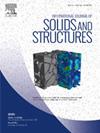Local field statistics in linear elastic unidirectional fibrous composites
IF 3.8
3区 工程技术
Q1 MECHANICS
International Journal of Solids and Structures
Pub Date : 2025-03-15
DOI:10.1016/j.ijsolstr.2025.113343
引用次数: 0
Abstract
Statistical fluctuations of local tensorial fields beyond the mean are relevant to predict localized failure or overall behavior of the inelastic composites. The expression for second moments of the local fields can be established using the Hill-Mandel condition. Complete estimation of the statistical fluctuations via second moments is usually ignored despite its significance. In Eshelby-based mean-field approaches, the second moments are evaluated through derivatives of Hill’s Polarization tensor using a singular approximation. Typically, semi-analytical procedures using numerical integration are used to evaluate the derivatives of the polarization tensor . Here, new analytically derived explicit expressions are presented for calculating the derivatives, specifically for unidirectional fibrous composites with isotropic phases. Full-field homogenization using finite element is used to compute the statistical distribution of local fields (exact solution) for the class of random fibrous microstructures. The mean-field estimates are validated with the exact solution across different fiber volume fractions and aspect ratios. The results indicate that the fiber volume fraction significantly influences the fluctuation of stress tensor invariants, whereas the aspect ratio has minimal effect.
线弹性单向纤维复合材料的局部场统计
局部张量场超过平均值的统计波动与预测非弹性复合材料的局部破坏或整体行为有关。利用Hill-Mandel条件可以建立局部场的二阶矩表达式。通过秒矩对统计波动的完全估计虽然很重要,但通常被忽略。在基于eshelby的平均场方法中,利用奇异近似通过希尔偏振张量的导数来计算二阶矩。通常,使用数值积分的半解析过程被用来计算偏振张量Po的导数。本文针对具有各向同性相的单向纤维复合材料,提出了新的解析推导式。利用有限元的全场均匀化方法计算了一类随机纤维微结构局部场的统计分布(精确解)。通过不同纤维体积分数和长径比的精确解验证了平均场估计。结果表明,纤维体积分数对应力张量不变量的波动有显著影响,而长径比对应力张量不变量的影响较小。
本文章由计算机程序翻译,如有差异,请以英文原文为准。
求助全文
约1分钟内获得全文
求助全文
来源期刊
CiteScore
6.70
自引率
8.30%
发文量
405
审稿时长
70 days
期刊介绍:
The International Journal of Solids and Structures has as its objective the publication and dissemination of original research in Mechanics of Solids and Structures as a field of Applied Science and Engineering. It fosters thus the exchange of ideas among workers in different parts of the world and also among workers who emphasize different aspects of the foundations and applications of the field.
Standing as it does at the cross-roads of Materials Science, Life Sciences, Mathematics, Physics and Engineering Design, the Mechanics of Solids and Structures is experiencing considerable growth as a result of recent technological advances. The Journal, by providing an international medium of communication, is encouraging this growth and is encompassing all aspects of the field from the more classical problems of structural analysis to mechanics of solids continually interacting with other media and including fracture, flow, wave propagation, heat transfer, thermal effects in solids, optimum design methods, model analysis, structural topology and numerical techniques. Interest extends to both inorganic and organic solids and structures.

 求助内容:
求助内容: 应助结果提醒方式:
应助结果提醒方式:


